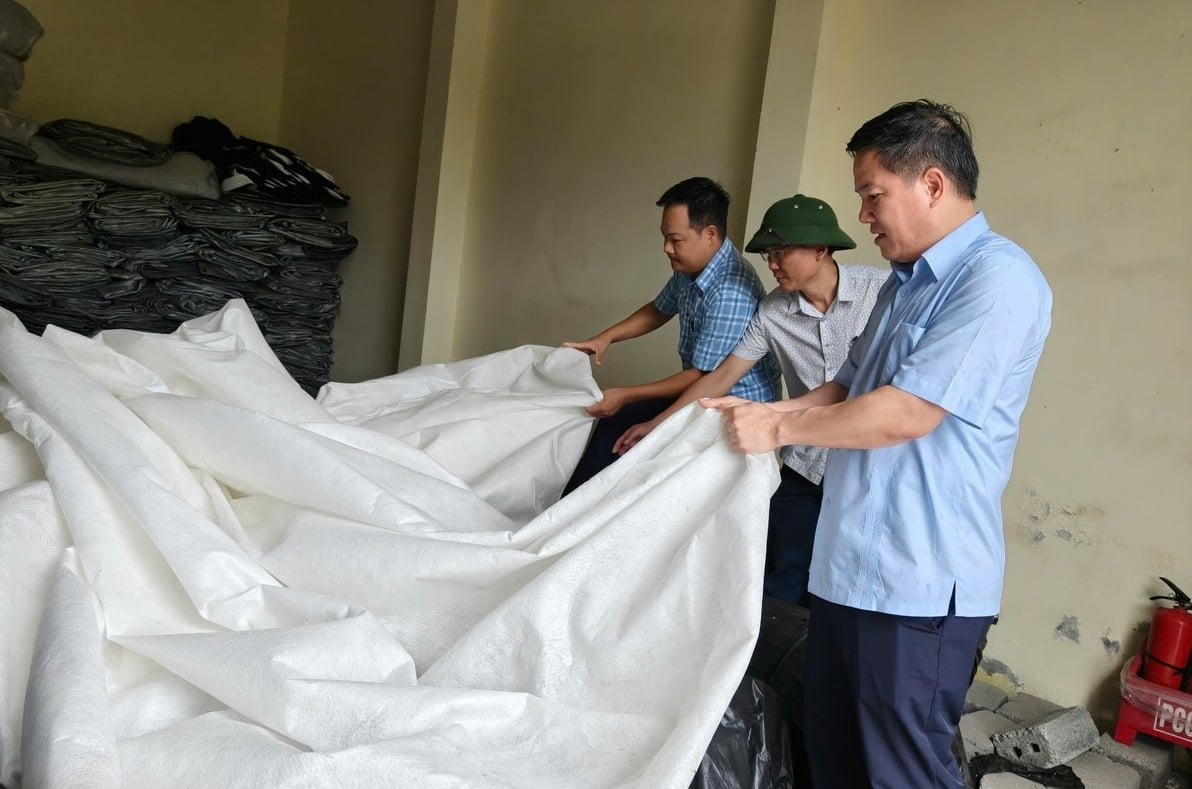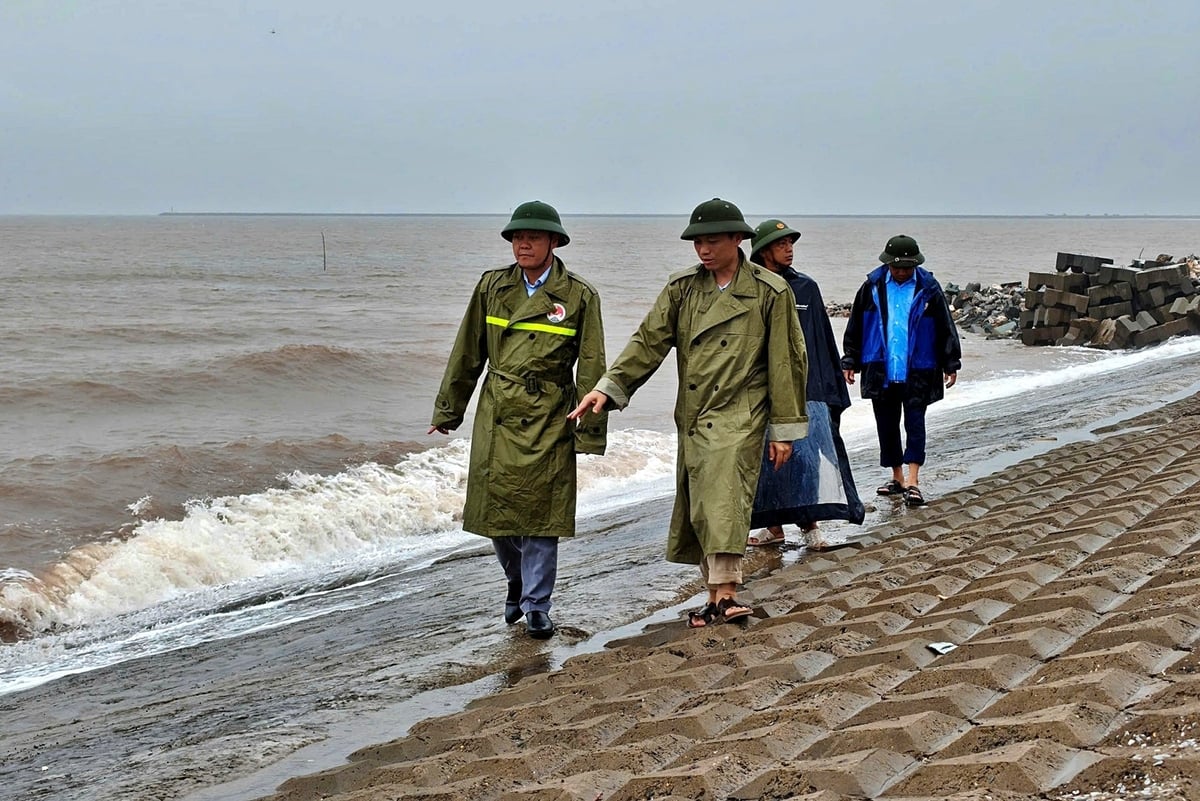November 24, 2025 | 00:07 GMT +7
November 24, 2025 | 00:07 GMT +7
Hotline: 0913.378.918
November 24, 2025 | 00:07 GMT +7
Hotline: 0913.378.918
On the evening of July 21, after a long day battling relentless rain and wind, Bui Xuan Dieu, Deputy Director of the Ninh Binh Department of Agriculture and Environment, phoned home to apologize for missing dinner. “Most of the staff in the neighboring communes are newly rotated. A big typhoon like this is really throwing us off,” he told reporters.

Deputy Director Bui Xuan Dieu conducting a logistics inspection for the Typhoon Wipha prevention and control operations. Photo: Bao Thang.
Ninh Binh’s two-tier local government model faced its first real test with Typhoon Wipha. Though Mr. Dieu has weathered countless storms and challenges over the years, this one feels particularly daunting. not because of doubts about the “four on-site” and “three ready” principles, but because the newly established commune-level governments, operational for just a few weeks, might not yet run smoothly.
Since Sunday, when Typhoon Wipha began showing signs of unpredictable development, Mr. Dieu and teams from the provincial department have been stationed in key areas. They’ve been directly inspecting weak dike sections and high-risk points along the coastal districts of Kim Son, Yen Mo, and Gia Vien.
“The commune authorities are now expected to take on many responsibilities that used to fall to the districts. But we’re short-staffed, and the teams are still new here. We also lack hands-on experience in disaster response,” he admitted.
To make up for these early gaps at the grassroots level, Mr. Dieu has personally taken a more hands-on role, directing operations and inspecting sites as both the Deputy Director of the Department and a key figure in the province’s disaster response efforts.
He stressed that the Steering Committee has doubled down on the “four on-site” approach to ensure an effective response to Typhoon Wipha. The motto focuses on on-site command, manpower, materials and equipment, funding, and logistics. After inspecting the dikes and embankments in any commune, he always checks the materials stockpile. Sandbags, bamboo, tarpaulins, tools, personnel, and priority protection zones are all meticulously accounted for, down to exact quantities and quotas.

The Irrigation Sub-Department and Hai Hau Dike Management Unit are collaborating with officials from the Dike Management and Disaster Prevention and Control Department to investigate critical locations before Typhoon Wipha. Photo: Bao Thang.
The two-tier model is unfamiliar to Nguyen Van Long, Chairman of Hai Thinh Commune. For Deputy Director Bui Xuan Dieu, it meant endless phone calls in the pitch-dark hours before the storm. “In the past, disaster response came from the district level,” Mr. Long explained. “Now, many responsibilities have been pushed down to the communes, where resources are thin and technical capacity is limited.”
Hai Thinh is not alone. Across Ninh Binh, newly merged communes are all learning by doing. For Mr. Long, the biggest challenge is not the community’s spirit. Coastal officials and residents are no strangers to hardship, but the strain of running a system that hasn’t yet been tested in a real emergency.
For Typhoon Wipha, the province handed communes detailed, clearly defined tasks. “The local government now feels like a frontline unit – planning, organizing, and executing everything,” Mr. Long said. Still, he hopes for stronger coordination between communes, more flexible staffing, and faster-response support tools. These are gaps that cannot be filled overnight.
Yet it’s precisely in moments like this that community resilience shines. In Hai Thinh, neighborhood groups, women’s unions, veterans’ associations, and youth unions all rallied, alongside the commune’s emergency team. Teams carried hoes, tarps, and sandbags to fortify dikes and patrol the rising tides. Houses near the sea gate were reinforced early, and some families set up backup lighting in case of power cuts.
On the eve of Typhoon Wipha’s landfall, the story in Hai Thinh was about more than relocating hundreds of households and securing thousands of boats. It was about the spirit of self-reliance among the commune’s 33,000 residents. As the wind howled outside, Mr. Long said quietly, “We’re doing everything we can, because the damage could be beyond anyone’s prediction.”
The typhoon's circulation has unleashed torrential rains, much like the pressure the Hai Thinh commune government is bearing, despite the fact that the eye of Typhoon Wipha is still tens of kilometers from the Ninh Binh coast. There, the issue is not solely about preventing water from overflowing the dikes; it also involves the challenge of organizational structure, response scenarios, and the cohesion between organizations and individuals.
Translated by Linh Linh

(VAN) Applying green technology in rural water supply and sanitation helps improve resource efficiency, protect the environment, and enhance community living standards.

(VAN) Developing biosecure livestock production is the key that helps Tuyen Quang form linked chains in livestock production and build its brand in the market.

(VAN) During his bilateral activities in South Africa, Prime Minister Pham Minh Chinh welcomed Vice President of the South African Chamber of Commerce and Industry Neil Pollock.

(VAN) Prof. Dr. Hoang Van Cuong, National Assembly Deputy of the 14th and 15th terms, shares recent pioneering policy decisions.

(VAN) Deputy Minister Tran Thanh Nam directed a comprehensive reform of the agricultural extension system, emphasizing professionalism and connecting farmers with the market.
/2025/11/22/3633-1-072521_760.jpg)
(VAN) The signing ceremony took place under the witness of Prime Minister Pham Minh Chinh and President of the Republic of South Africa Cyril Ramaphosa.

(VAN) Severe flooding in Khanh Hoa Province has caused catastrophic damage estimated at around USD 30 million, with the agriculture and irrigation sectors alone accounting for roughly USD 15.7 million in losses.